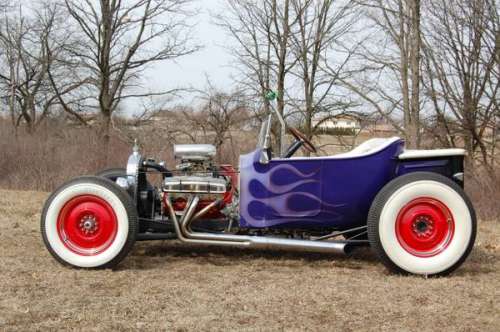According to the information on the website for the Alternative Fuels Data Center, under the United States Department of energy, (www.afdc.energy.gov) there are seven types of fuel used by vehicles in the United States today: Biodiesel, Electricity, Ethanol, Hydrogen, Natural Gas, Propane and Gasoline. Here is a breakdown of their advantages, disadvantages and use by both passenger and commercial vehicles.

1923 Ford T-Bucket
Biodiesel and regular diesel fuel are now the same. The fuel is made by mixing vegetable oils, yellow grease and tallow with diesel oil in various proportions to meet the needs of the Energy Policy Act (EPA) of 1992 and consumers. Federal regulations lowered the sulfur content in diesel fuel which also lowered its lubricating ability and biodiesel fuel compensates for that loss. As of 2010 all diesel vehicles must use "clean diesel" which means that there are no more than 15 ppm of sulfur in the fuel and biodiesel fuel also meets that requirement. Some blends are as low as one percent biological products but 20 percent is the most common, known as B20. Laws governing the requirements and incentives for using it vary by state and fuel consumption, horsepower and engine torque are about the same using B20 compared to straight diesel oil so it has become widely acceptable.
Electricity has always been an attractive energy source for vehicles and high gasoline prices have driven engineers and scientists towards making it competitive. There are three types of electric vehicle offered today. The Hybrid Electric automatically combines the power of a gasoline engine and electric motor to meet the driver's needs and the engine and breaks keep the batteries charged so it does do not require a charging station. The Plug-in Hybrid is similar but the gasoline engine and electric motor are more independent and the batters can be recharge at a charging station. And the All-Electric vehicle gets some rejuvenation from the brakes but otherwise is totally dependent on charging stations. The lack of charging stations throughout the country are a drawback for electric vehicles however the primary issue with consumers is cost. Even with the tax breaks and incentives offered by federal and state governments they are still more expensive than gasoline engine powered vehicles.
Ethanol is pure grain alcohol commonly made by distilling fermented corn and its use as a gasoline blend has met with limited success. Some argue that it uses more energy to make than it saves and damages some engine seals. Others point out that it reduces our dependency on foreign oil and reduces emissions. The most common blend is called E85 which is gasoline mixed with between 51 and 83 percent ethanol. Ethanol itself is a highly volatile, high octane fuel but the mixture in E85 produces about 27 percent less energy than gasoline. Ethanol works best in Flexible Fuel vehicles, which are modified to better handle its unique characteristics and both state and federal governments offer a variety of incentives for its use, but it is usually more expensive than gasoline and distribution is very limited.
Hydrogen can be made to produce electricity from a fuel cell which in turn can run an electric motor to power a vehicle. However at this time the fuel cells are too expensive to be competitive and distribution of hydrogen gas is almost nonexistent. The federal government has been encouraging the development of hydrogen as a means of reducing dependency on foreign oil and because the byproduct is water, without pollution. However hydrogen is a very volatile high-pressure gas that will require special handling and we are a long way from making it a common fuel source.
Natural Gas has been in use for years and there are now over 100,000 vehicles in the United States (almost 15 million worldwide) that have been converted to its use. Compressed natural gas (CNG) is ideal for fleets that can be refueled at a central location and liquified natural gas (LNG) is better for long distances because it is more readily available. Natural gas produces speed and horsepower similar to gasoline and produces less emissions but it's a volatile fuel that requires special handling. Vehicles can be modified to handle pure natural gas or a combination of natural gas and gasoline but their storage tanks are heavy, limiting their use on passenger vehicles.
Propane is commonly available and has been in use as an alternative fuel for vehicles for decades. There are currently nearly 300,000 propane powered vehicles on the road in the United States, most of which are fleets that can be refueled at a central location. Propane characteristics are similar to gasoline and vehicles can be modified to work on either fuel. However, like natural gas, propane requires heavy storage tanks making it unattractive to passenger vehicles designers.
Gasoline is still the most common vehicle fuel used in the United States and while the government is encouraging alternatives to our dependency on foreign oil and the harmful emissions produced by gasoline, it is still relatively inexpensive and, most importantly, has the largest distribution system.



